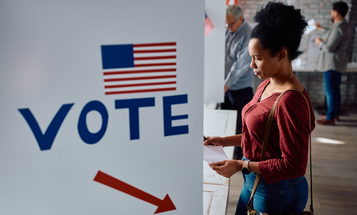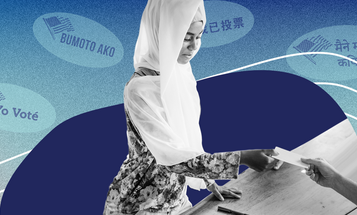
First Citizens: Increasing Voting Among American Indians and Alaska Natives
There’s been a lot of fighting the last several months about new restrictions on the right to vote. We learn that these laws, including voter ID, rules around registration, and limits on early voting disproportionately impact African Americans, Latinos, youth and other groups, many of which already have lower participation rates than the white population.
There is one group that we don’t hear about in this debate but similarly has unacceptably low voter rates: American Indians and Alaska Natives. Given that they are America’s first true citizens, it is time that this disparity be part of the discussion and, more importantly, be addressed. Today we published our report on this issue: Ensuring Access to the Ballot for American Indians & Alaska Natives.
Almost two out of five eligible American Indians and Alaska Natives are not registered to vote. Even among registered American Indians and Alaska Natives, the turnout rate is 5 to 14 percentage points lower than that of many of the registered voters of other racial and ethnic groups.
The voter participation rate of American Indians and Alaska Natives is among the lowest of any ethnic group in the country. There are historical reasons for this, but we’re not talking about long ago history in a school book. In relatively recent times, state governments found ways to deny American Indians and Alaska Natives the right to vote outright. For example, some states argued that Indians were not residents of the state and therefore ineligible to vote until these policies were overturned through legal challenges beginning in the 1950s and 1960s. American Indians could not vote in New Mexico until 1962. South Dakota legally denied American Indians the right to vote under state law until the 1940s, and then continued to deny them the vote until 1975 by claiming that people residing in “unorganized counties” were not eligible to vote. The three unorganized counties were Todd, Shannon, and Washabaugh -- counties overwhelmingly comprised of American Indians. Native Americans have been discriminated against and disenfranchised through a variety of methods -- including restrictive identification laws and purges of registration lists -- in even our most recent elections.
Increasingly, American Indians and Alaska Natives have been recognizing the need to improve the lives of their families and communities by expanding their political power, including through the ballot box.
Yet obstacles remain. Native Americans have been discriminated against and disenfranchised through a variety of methods – including restrictive identification laws and purges of registration lists -- in our most recent elections. And although there are cultural and historical reasons for the disparity in participation, census data reveals that the voter registration system is contributing to the problem.
In the Current Population Survey, American Indians and Alaska Natives cited various reasons why they were not registered to vote that include difficulties with the system, such as being unable to meet registration deadlines (13.6percent), lack of knowledge of where or how to register (6.6 percent), permanent illness or disability (6 percent), and difficulty with English (2 percent).
The National Congress of American Indians is working with other groups to overcome these obstacles. For example, it has entered into a new partnership with Rock the Vote that allows the Native Vote campaign to provide resources for online voter registration through NativeVote.org. The organization is also launching a “Tools for All” partnership with State Voices – a national civic engagement network. The partnership offers the chance for tribes to access voter outreach tools that can identify tribal members who need to register and encourage all tribal citizens to make their voice heard.
Nonetheless, given the history of manipulation, discrimination and forcible exclusion from the voting process by governments, and the federal government’s constitutional obligations to Indian Americans and Alaska Natives, government also needs to play a role by making voter registration more accessible to this population. This can be done through Indian Health Services (IHS), a federal entity within the U.S. Department of Health and Human Services. IHS should assist its clientele – which includes the vast majority of American Indians – to register to vote systematically and year-round. This would mean that assigned staff at an appropriate IHS facility would provide each client with a voter registration form (in all mandated languages) and the opportunity to fill it out should the client wish to do so. Staff would also assist the client with the form if necessary and then collect and transmit it to the appropriate local election official. We know that with effective implementation this type of system can have an incredible impact. Demos has repeatedly found that voter registration applications rise exponentially when state based public assistance agencies have instituted effective voter registration programs in accordance with the NVRA.
Our democracy is stronger when all of our citizens participate, and this is all the more true in the case of American Indians and Alaska Natives. The relatively low level of participation of the Native communit yis particularly salient given the historical mistreatment of the American Indian community. When we talk about voter disenfranchisement and how to combat it – a big topic of discussion these days – American Indians should be a central part of the discussion.



